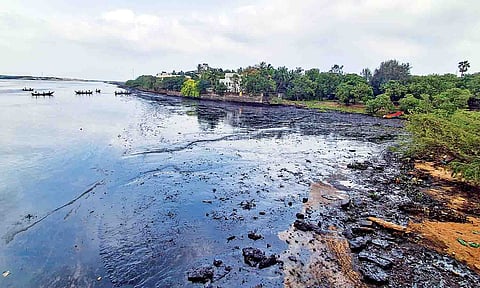

CHENNAI: In an effort to restore the fragile ecosystem of the Ennore estuary, the State Forest Department has dug a dozen freshwater ponds across 230 hectares to support the regeneration of mangroves, amid persistent pollution from industrial effluents and thermal power discharges.
The Ennore estuary and the adjoining Kosasthalaiyar River have long suffered from chemical contamination and thermal pollution, particularly due to the discharge of hot coolant water from the Tangedco thermal power plant.
Recognising the environmental degradation, the department has initiated a mangrove restoration programme using a water-retention strategy to overcome the challenges of a toxic estuarine environment.
According to Environment Secretary Supriya Sahu, each of the 12 ponds is four metres deep and has been constructed on dry land across several locations where tidal inflow alone cannot sustain mangrove roots. “These ponds hold fresh water and are designed to receive tidal inflow as well. In many of the dry island areas near Ennore, the roots of mangroves were unable to access water. This intervention is meant to address that issue,” she explained.
The department has planted around 1.6 lakh mangrove seedlings and another two lakh mangrove associate species such as Avicennia marina, Rhizophora mucronata, and Excoecaria agallocha. The ponds are expected not only to help root establishment but also to improve fish breeding and support aquatic biodiversity.
The restoration drive spans nine villages, including Puzhuthivakkam, Kattupalli, and Edayanchavadi, where different planting methods – such as the fishbone and linear techniques – were adopted based on detailed soil and water analysis.
“Around 32,000 mangrove seedlings and 40,000 mangrove associate plants are being raised to replace those lost during last year’s southwest monsoon,” she added.
However, despite the government’s ecological push, local fishermen say pollution remains rampant. Fisherfolk from Kattukuppam, one of Ennore’s major fishing hamlets, allege that “industries continue to release untreated effluents, including oil and petroleum waste, into the river”.
Activists have echoed these concerns, demanding stricter enforcement of pollution control norms and real-time monitoring of industrial discharge. While the State’s initiative is being lauded as a scientifically sound approach to mangrove revival, experts warn that without curbing ongoing pollution and regulating industrial activity, the restoration efforts may not be sustainable in the long run.
The Ennore creek area, rich in biodiversity and crucial for local livelihoods, has been under environmental stress for over two decades due to the unchecked expansion of thermal power stations, petrochemical facilities, and ports.
The department, meanwhile, has assured that it will continue weekly monitoring of the saplings and the water quality in the newly created ponds. “This is not a one-time intervention. It’s a long-term ecological commitment,” said an official overseeing the project.